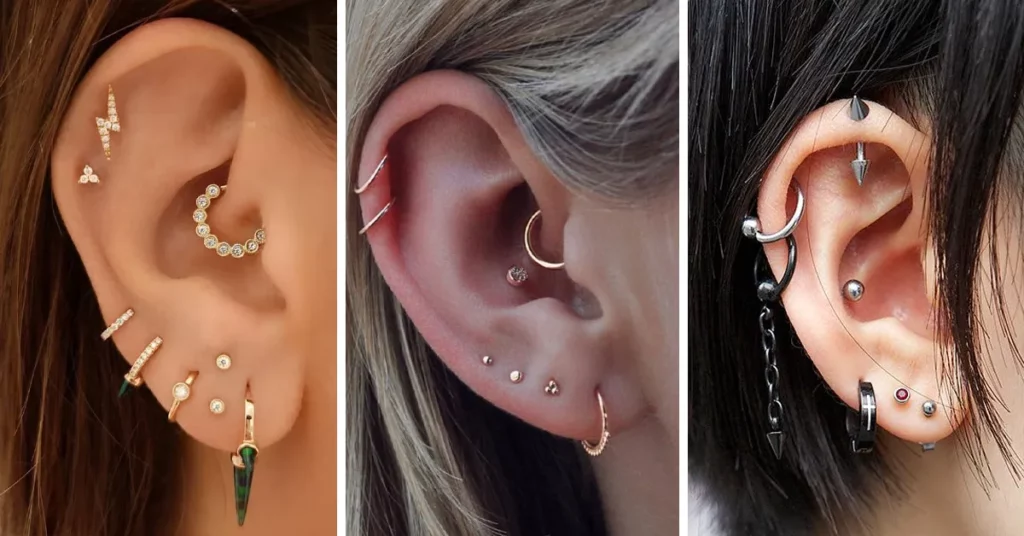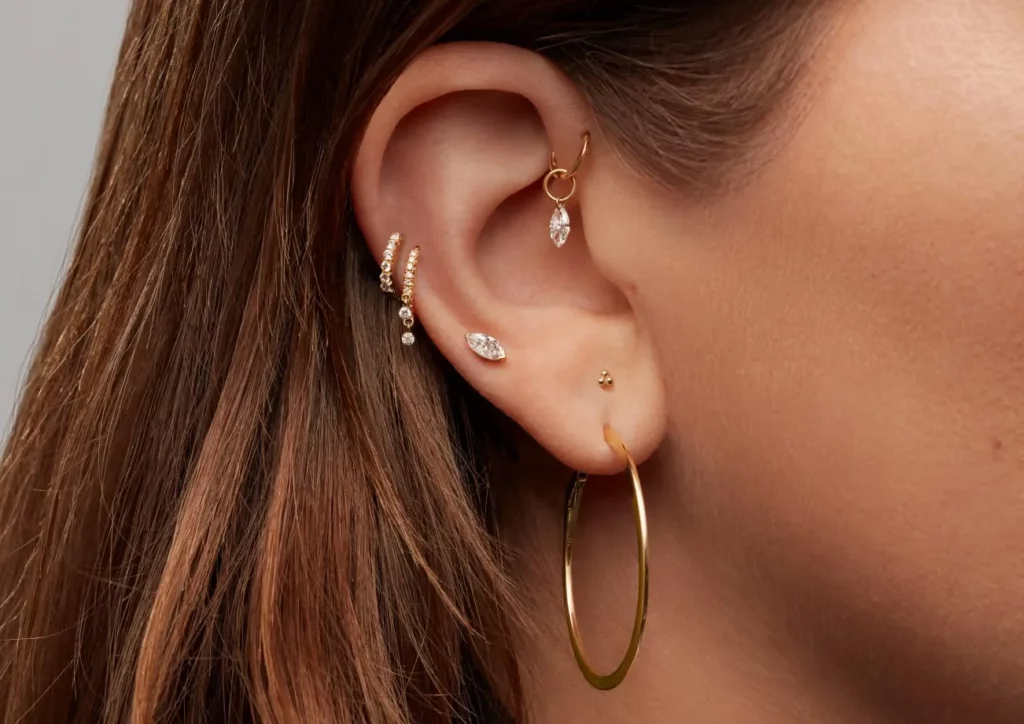- Introduction
- Understanding Double Helix Piercing
- I. The Process of Getting a Double Helix Piercing
- II. Does a Double Helix Piercing Cause Discomfort?
- III. How Much Does a Double Helix Piercing Cost?
- IV. How Long Does It Take for a Double Helix Piercing to Heal?
- V. How Can You Prevent Infections in Your Double Helix Piercing?
- VI. Advanced Jewelry Options
- FAQs
- Conclusion
Introduction

Image Credit: [Laura Bond]
In recent years, the double helix piercing has taken the world of body modification by storm, offering a stylish and trendy means of self-expression through ear adornments. In this extensive guide, we embark on an in-depth journey into the realm of double helix piercings, leaving no stone unturned as we explore the core question, “What is a double helix piercing?” Our journey goes beyond the basics, delving into the intricate details of the procedure, the potential discomfort, the associated costs, the healing process, and the critical strategies to prevent infection. This article stands as a comprehensive and unparalleled resource for anyone curious about the fascinating world of double helix piercing.
Understanding Double Helix Piercing
The double helix piercing is a unique and individualistic form of ear piercing, characterized by the perforation of the outer ear’s cartilage in a specific configuration. Its nomenclature draws inspiration from its uncanny resemblance to the double-stranded helical structure of DNA. This intricate piercing process entails the creation of two punctures in the upper ear cartilage, often embellished with distinct pieces of jewelry. The end result is a captivating and eye-catching look that diverges from the conventional earlobe piercings, exuding an aura of distinctiveness and flair.
I. The Process of Getting a Double Helix Piercing

Image Credit: [Inspire Uplift Blog]
Obtaining a double helix piercing is a bit more intricate than a standard lobe piercing, but it is still a relatively straightforward procedure. Here is an overview of the typical process:
- Consultation: It is advisable to consult with a professional piercer before undergoing any piercing. During this consultation, the piercer will assess your ear’s suitability for a double helix piercing. They will discuss your preferences, including the type of jewelry and placement, and guide aftercare.
- Sterilization: The piercing equipment is meticulously sterilized to minimize the risk of infection. The area of your ear that will be pierced is also thoroughly cleaned.
- Marking: Using a pen, the piercer marks the precise spots where the piercing will be performed. This step is crucial to ensure symmetry and precision.
- Piercing: A sterilized needle or hollow piercing needle is used to create the holes in your cartilage. While the process can be uncomfortable, the pain is generally brief.
- Jewelry Insertion: Following the piercing, the chosen jewelry, which typically consists of studs or hoops, is inserted into the fresh piercings. The piercer secures the jewelry with a back or screw-on cap.
- Aftercare: The piercer will provide you with detailed aftercare instructions to ensure the proper healing of your double helix piercings. This typically involves cleaning, avoiding certain activities, and using saline solutions.
II. Does a Double Helix Piercing Cause Discomfort?
One of the most frequently asked questions about double helix piercings pertains to the level of discomfort they entail. The perception of pain can vary from person to person, but it is essential to have realistic expectations.
The pain experienced during a double helix piercing is usually described as a sharp, stinging sensation that lasts only for a few seconds as the needle passes through the cartilage. Some individuals may find it uncomfortable, while others may experience more intense pain. Nevertheless, the discomfort typically subsides quickly.
It’s important to note that the initial pain is relatively short-lived, and the overall discomfort is generally mild. If you have a low pain threshold, you can consider taking over-the-counter pain relievers before the procedure, but it is crucial to consult with your piercer or a medical professional for guidance.
III. How Much Does a Double Helix Piercing Cost?

Image Credit: [Piercee]
The cost of a double helix piercing can vary significantly depending on several factors, such as the location of the piercing studio, the experience of the piercer, the type of jewelry chosen, and the geographic location. On average, you can expect to pay between $40 and $100 for each hole, making a double helix piercing potentially cost between $80 and $200. Several cost factors need to be taken into account:
- Piercing Studio: High-end piercing studios in larger cities may charge more than smaller, local studios.
- Experience of the Piercer: Experienced piercers often charge more for their services, as they can provide a safer and more precise piercing experience.
- Jewelry Choice: The cost of jewelry varies depending on the material and design. Simple stainless steel or titanium jewelry is more affordable than options made from gold or gemstones.
- Geographic Location: Prices can vary significantly by region or country. Urban areas generally have higher costs compared to rural areas.
While considering the cost is important, it is equally crucial not to compromise on quality in pursuit of a lower price. Opt for a reputable piercing studio with experienced professionals who prioritize your safety and hygiene.
IV. How Long Does It Take for a Double Helix Piercing to Heal?
The healing process for a double helix piercing can be somewhat lengthier and more involved compared to lobe piercings, as cartilage piercings typically take more time to fully heal. Typically, a double helix piercing progresses through several healing stages, which may take 3 to 6 months or even longer. Here is a rough breakdown of these healing stages:
- Initial Healing (Week 1-3): During the first few weeks, you’ll need to exercise extra caution. The area may exhibit redness, swelling, and mild discomfort. Proper cleaning and aftercare are crucial during this stage to prevent infection.
- Intermediate Healing (Week 4-8): By this time, the swelling should begin to subside, and the pain will lessen. However, the area may remain sensitive.
- Full Healing (3-6 Months): The piercing is considered fully healed when there is no pain, redness, swelling, or discharge. You can change the jewelry after it has completely healed.
To ensure a smooth healing process, it is essential to follow the aftercare instructions provided by your piercer meticulously. This typically involves cleaning the area with a saline solution and refraining from touching the piercings with unwashed hands or applying any harsh products.
V. How Can You Prevent Infections in Your Double Helix Piercing?
Preventing infection is a top priority when caring for your double helix piercings. Here are some crucial tips to help minimize the risk of infection:
Maintain Cleanliness: Ensure that the area remains clean by gently cleaning it with a saline solution. Avoid using alcohol or hydrogen peroxide, as these substances can be harsh and hinder the healing process.
Keep Your Hands Off: Avoid touching your piercings with unclean hands. Refrain from twisting or turning the jewelry.
Avoid Swimming: Stay away from pools, hot tubs, and natural bodies of water while your piercings are healing, as these environments can introduce harmful bacteria.
Choose the Right Jewelry: Opt for high-quality jewelry made from materials like surgical stainless steel, titanium, or niobium. Low-quality jewelry can cause irritation and increase the risk of infection.
Haircare: Keep your hair away from your piercings, especially if you have long hair, as hair can carry dirt and bacteria.
Avoid Overcleaning: Cleaning your piercings too frequently can be counterproductive. Adhere to the aftercare routine recommended by your piercer.
Consult a Professional: If you notice any signs of infection, such as persistent redness, swelling, discharge, or pain, consult your piercer or a healthcare professional promptly. Early treatment is crucial to prevent complications.
VI. Advanced Jewelry Options

Image Credit: [Maria Trash]
Advancements in jewelry options have expanded the possibilities for double helix piercings. Beyond the classic studs and hoops, individuals can now explore various jewelry types, including
- Threadless Jewelry: Threadless jewelry systems employ a push-in and pull-out mechanism, eliminating the need for threading small parts. This not only makes changing jewelry easier but also reduces the risk of irritation during the process.
- Seamless Rings: Seamless rings offer a continuous and elegant look, with no visible seam or opening. They can be a stylish choice for double helix piercings.
- Ear Cuffs: Ear cuffs are a non-piercing alternative that clings to the ear’s cartilage, creating the illusion of a piercing. They come in various designs and materials, allowing for versatile styling.
- Dangle Earrings: For a more intricate and ornate look, consider dangle earrings designed specifically for cartilage piercings. These can add a touch of elegance to your double helix.
Many piercers offer custom jewelry options, allowing you to personalize your double helix piercings with unique designs or materials, including gemstones or engravings. These advanced jewelry options provide you with the freedom to express your individual style and elevate your double helix piercing to the next level.
FAQs
1. Is a double helix piercing the same as a cartilage piercing?
A double helix piercing is a type of cartilage piercing. Cartilage piercings can be done in various locations on the outer ear, and a double helix piercing specifically involves two holes in the upper ear cartilage.
2. How long does a double helix piercing procedure take?
The piercing process itself typically takes only a few minutes for both holes. However, this may vary depending on your piercer’s speed and technique.
3. Can I get both piercings done at the same time, or should I do one at a time?
While it’s possible to get both double helix piercings done in a single session, it may increase the initial discomfort and healing challenges. Some people prefer to space them out, allowing one side to heal before piercing the other.
4. Are there any age restrictions for double helix piercings?
Age restrictions for body piercings vary by location and studio. In many places, you must be at least 16 to 18 years old, and some studios may require parental consent for minors. Check with your local piercing studio for specific age requirements.
5. Can I change my jewelry during the healing process?
It’s not recommended to change the jewelry until the piercing is fully healed, which typically takes 3 to 6 months. Changing it too soon can disrupt the healing process and increase the risk of complications.
6. Can I sleep on my side with a fresh double helix piercing?
It’s generally advised to avoid sleeping on the side with the fresh piercings during the initial healing period to prevent irritation. If necessary, you can use a travel pillow to support your head without putting pressure on the piercings.
Conclusion
Double helix piercings offer a creative and stylish means to personalize your ear jewelry, adding a unique touch to your appearance. While they require some patience and diligence during the healing process, the results are often well worth the effort. By understanding the intricacies of double helix piercings, being aware of potential discomfort, considering the cost, and adhering to proper aftercare practices, you can ensure a safe and successful piercing experience. Remember to prioritize hygiene and seek guidance from professionals whenever you have concerns, and you’ll enjoy your double helix piercings for years to come.


